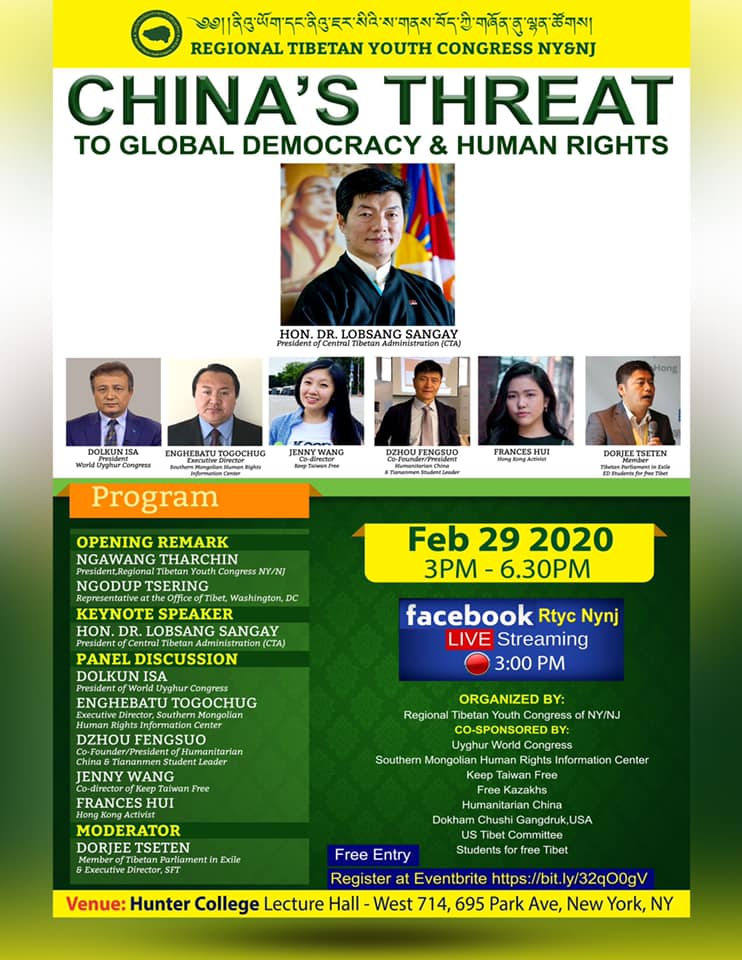| SMHRIC |
| March 1, 2020 |
| New York |
|
|
|
|
SMHRIC Director Enghebatu Togochog speaks at "China's Threat to Global Democracy and Human Rights" (SMHRIC - 2020-03-01) |
|
The following is a speech of Enghebatu Togochog, Director of SMHRIC, made at the "China's Threat to Global Democracy and Human Rights" conference held at Hunter College in New York:
Sain baitsagaanuu? Dashi Delek!
Happy Losar to my Tibetan brothers and sisters!
First of all, I would like to thank my dear brother Ngawang Tharchin and his team for giving us this opportunity to become a co-organizer of this event. My name is Enghebatu Togochog.
I am a Mongolian from Southern Mongolia which is another nation occupied and colonized by China, like Tibet and East Turkistan.
As you all know, in 1949, the Chinese Communist Party took control over China proper. Soon after, our three nations, Southern Mongolia, Tibet and East Turkistan, were overrun by the Chinese Communist Party. Our sovereignty was replaced with autonomy which existed only on name; our national territory was reduced to “Autonomous Region”; our people were downgraded to “ethnic minorities” on our own land. Southern Mongolia was the guinea pig of China’s ethnic policy experiment; all of China’s ethnic policies including large-scale genocide, ethnic cleansing, political purge, population transfer, economic exploitation, cultural eradication and environmental destruction have been formulated, tested and validated their effectiveness in Southern Mongolia. During the past 7 decades of Chinese colonial rule, Southern Mongolia has experienced at least three waves of ethnic cleansing or genocide campaigns:
As early as 1947 even before the establishment of the People’s Republic of China, the CCP orchestrated and carried out the so-called “Land Reform Movement” in Southern Mongolia to execute around 20,000 Mongolians and effectively confiscated Mongolian land; And during the 1950s, the Government of China carried out another wave of political witch-hunt to arrest, imprison and execute thousands of Southern Mongolian elites under of name of “anti-national-rightest” movement; The genocide par excellence of CCP took place during the late 1960s and early 1970s. At least 100,000 Southern Mongolians were killed and a half million were arrested, imprisoned and tortured.
Once the physical genocide of Southern Mongolian nation was concluded with triumph, the Government of China experimented another form of genocide “Cultural genocide” or “ethnocide” in Southern Mongolia starting 2001. The entire Mongolian rural population and nomadic civilization as a whole were put to trial. Practicing the traditional way of life and raising livestock on their ancestral grazing land became a crime. The grassland that was the foundation of nomadic civilization has completely been destroyed by the Chinese miners and colonial settlers.
Proven their effectiveness in Southern Mongolia, these genocides, ethnocides, and ecocides were soon carried out in Tibet, and now implemented in East Turkistan in front of the eyes of international community. Chinese regime’s oppressive and brutal nature is not confined to its occupied nations and China proper. It has been a major threat to free and democratic world. Hong Kong is already on their plate, and Taiwan is on their menu.
Even more disturbing and worrisome development is that China is trying hard, and partially successful, to export colonialism to developing world and authoritarianism to democratic world. China is not sparing any opportunity from cross-continental projects like Road and Belt Initiative to community-targeted propaganda like Queen Library Exhibition.
Chinese money is at work everywhere from neighboring countries to central Asia, from Africa to South America. Even in the free and democratic world, Chinese money is threatening the core value of democracy, human rights and human dignity. One small example is Chinese embassy’s recent attempt to promote Chinese propaganda and brainwash American society about Tibet through a rather small exhibition at the public library right here in our neighborhood. But, one thing the Chinese Government miscalculated about is the power of resistance.
Thanks to the two-week powerful protests organized by our Tibetan brothers and sisters, China had to learn the lesson that their money is not always omnipotent. Here I would like to congratulate all of our Tibetan friends for their powerful and successful campaign to bring down the exhibition in Queen Public Library. Your action not only is inspirational to all of us, but also a proof that if we stand up together and resist together, there is still hope for freedom and democracy.
Thank you,
Enghebatu Togochog
Director Southern Mongolian Human Rights Information Center (SMHRIC)






 Beyond
Great Walls: Environment, Identity, and Development on the Chinese
Grasslands of Inner Mongolia
Beyond
Great Walls: Environment, Identity, and Development on the Chinese
Grasslands of Inner Mongolia China's
Pastoral Region: Sheep and Wool, Minority Nationalities, Rangeland
Degradation and Sustainable Development
China's
Pastoral Region: Sheep and Wool, Minority Nationalities, Rangeland
Degradation and Sustainable Development The
Ordos Plateau of China: An Endangered Environment (Unu Studies on
Critical Environmental Regions)
The
Ordos Plateau of China: An Endangered Environment (Unu Studies on
Critical Environmental Regions)